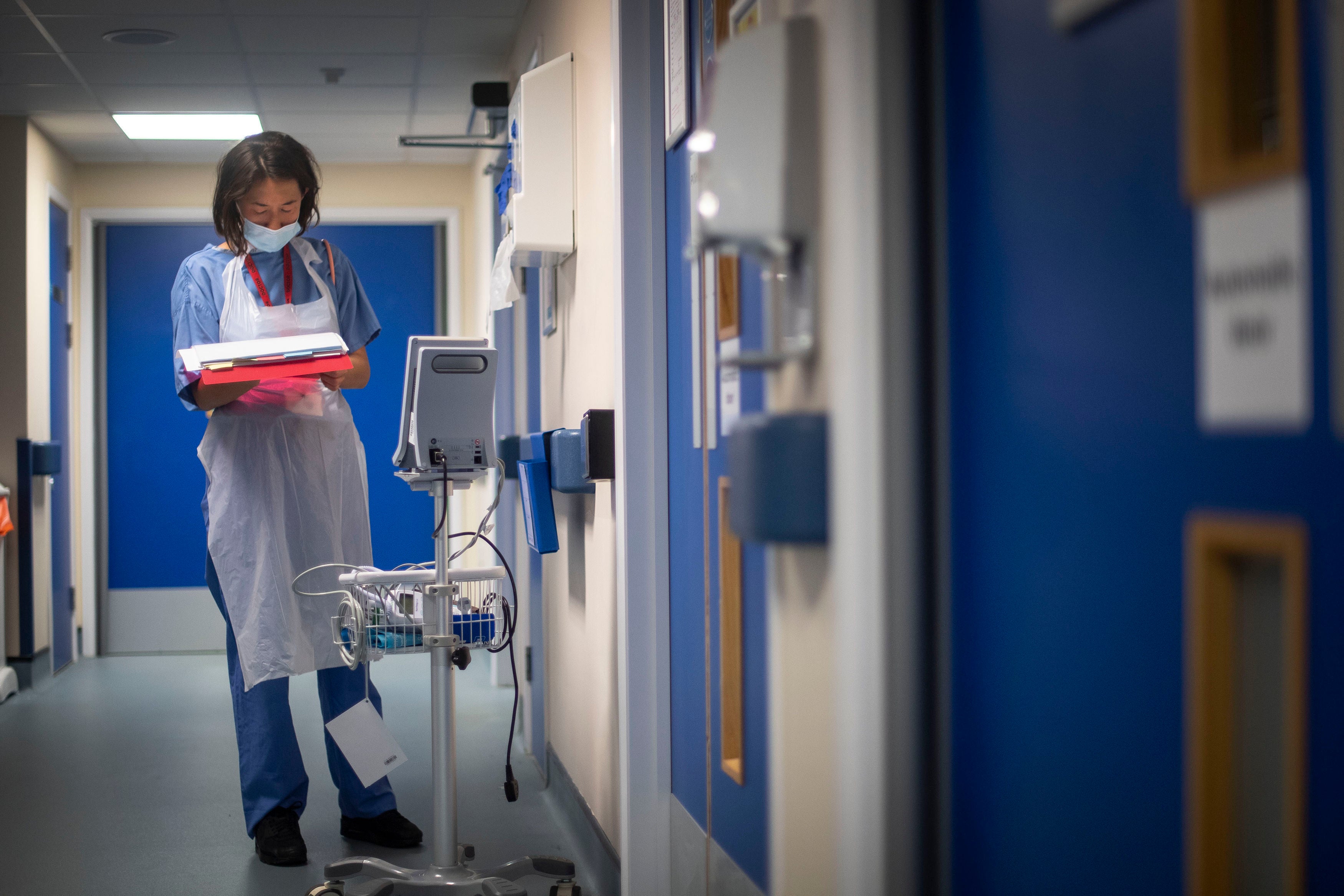Hospital trust accused of risking lives after raising patient-to-nurse ratio to dangerously high levels
Exclusive: Staff warn people ‘are going to unnecessarily die’ after major Bristol hospital trust introduces policy that will see one nurse assigned to 10 patients for all general adult wards
A hospital trust in Bristol has been accused of risking lives after raising its patient-to-nurse ward ratio to dangerously high levels, having allegedly dismissed staff concerns and national guidance on safe staffing.
University Hospitals Bristol and Weston NHS Foundation Trust (UHBW) has introduced a new policy across its hospitals that assigns one nurse to 10 patients (1:10) for all general adult wards. This ratio, which previously stood at 1:6 or 1:8 depending on the ward, rises to 1:12 for night shifts.
The measure, applicable to Bristol Royal Infirmary (BRI) and Weston General Hospital, has been temporarily implemented as a result of rising patient numbers - fuelled by the pandemic - and staff shortages.
Nurses at the trust have expressed their anger over the decision, saying they were never fully consulted by senior officials. Many are fearful that patient safety will be compromised as the second coronavirus wave intensifies, culminating in the unnecessary loss of life.
“Patients who would have extra nursing staff because they are very acutely unwell and need close observation I think are going to unnecessarily die,” one nurse at BRI told The Independent.
“Or if they survive, they’ll suffer long-term conditions because things were missed as they don’t have the staff at their bed side to watch the deterioration.”
Some nurses claims that they have been forced to look after up to 16 patients during their shifts due to severe staff shortages.
The trust’s new ratio exceeds guidance set out by National Institute for Health and Care Excellence (NICE), which warns that people are at risk of harm in wards where there is one nurse for eight or more patients.
The link between patient safety and nurse staffing levels has been repeatedly evidenced in research and was made clear during the public inquiry into the Stafford Hospital care disaster, in which hundreds of patients suffered neglect and abuse after hospital managers slashed nurse staffing levels to save money and meet targets.
Multiple peer-reviewed studies have shown a ratio of nurses to patients that is 1:8 or higher can also result in patient deaths on medical wards.
“Each area should be individually assessed,” another nurse said. “They’ve put in place a blanket policy which goes against NICE and doesn’t give any consideration to the needs of the different wards and their patients.” UHBW insists that assessments will be made on a ward-by-ward basis depending on the acute needs of patients.
Exemptions for the new nurse-patient ratio have been made for critical care and High Dependency Units (HDU), according to a leaked email circulated among managerial figures at Bristol Royal Infirmary.
In the email, sent out on 12 November, UHBW explained that the “difficult” decision had been made as a result of the “unprecedented times”, adding that the trust was in a “designated critical incident”.
“The Trust demand for agency nurses is outstripping supply – so we need to work on the basis that shifts will not all be covered,” the email reads.
“Nursing and midwifery leaders need to change their ‘mind set’ and risk tolerance of what is safe under business as usual and what is safe in an exceptional critical incident.
“Covering staffing gaps may need to include the use of non-nursing staff into support roles.”
UHBW told The Independent that specialist high-care wards are also exempt.
Carolyn Mills, chief nurse at UHBW, said: “These decisions are under constant review based on clinical and staffing needs on shift by shift basis while senior clinicians are also on hand to offer wellbeing support and care to colleagues if required.”
Nurses who have spoken with The Independent say they were informed about the new ratio via posters that were put up throughout Bristol Royal Infirmary. Others says they found out after a colleague obtained a copy of the email before circulating it among their peers.
In all but one case, where a ward manager communicated the changes to staff, no attempts were reportedly made to consult nurses about how their job responsibilities would be changing under the policy. UHBW disputes this and claims staff were consulted in advance of the new policy.
“It hasn't been spoken about with the people who are dealing with the conflicts that are going to arise from it,” a third nurse at BRI told The Independent. “At the end of the day it's unsafe patient care. It’s terrifying.
“When it comes down to treatment being missed or a patient having a fall because they're not being looked after properly, anything that's gone wrong down to human error, it’s going to come straight back to me and I'll risk losing my pin out of something which isn't safe to begin with and I have no control over.”
Nurses based in the hospital’s general wards said that they have not been given any guidance over how to handle their increased workload, which patients to care for first, what health demands to focus on and whether they should dismiss the basic duties of their job.
“Management aren’t even willing to have a discussion about what are the expectations of us. There have been no-follow up convos when staff asked about this,” the first nurse said. “In regard to nutrition are we expected to still help with that?
“Are we still expected to turn vulnerable people over every two to four hours? If people are incontinent are we expected to help them as quickly as before? Or is it just the normal thing that people who can’t go to the toilet themselves sit in dirty pants and their skin deteriorates further?
“If someone is deteriorating, are we expected to be there and forget eight or nine other patients while we look after this one sick deteriorating person? We just don’t know. It’s really frightening for us.”
Having already faced the brunt of the first wave, and suffered enormous mental strains as a result, nurses at BRI warned that their own wellbeing was on the line amid such conditions.
“Myself and many other nurses are finding a career we were once so passionate about crumbling before our eyes,” a member of staff told The Independent. “We are tired, burnt out, stressed and anxious walking into the hospital, completely unaware of what to expect day to day.”
Another said that there had been no additional mental health support rolled out for nurses at the hospital, despite the increased work demands.
Last month, The Independent reported that fears are mounting for the wellbeing of thousands of NHS doctors and nurses who are suffering from burnout during the coronavirus pandemic, with mental health conditions accounting for up to 20 per cent of absences at leading hospitals.

The issue is expected to become more acute as hospitalisations from Covid-19 continue to rise during the second wave, experts warned, placing greater pressure on under-staffed wards while jeopardising patient safety.
One nurse associated with the campaign group Nurses Say No Bristol expressed concern that the new ratio would become the norm for the Trust throughout the rest of the pandemic and beyond.
“If this does work and there are no adverse reactions to it, is this going to become the new norm?” he told The Independent. “Management might say ‘You managed during the cover crisis, you’ll just have to stick to this’.”
He insisted that if nurses were going to be burdened with more work, it was only fair to increase wages and ensure the appropriate safety and support protocols are put in place. He added that management at UHBW needed to introduce a rolling review of all near-misses and accidents for wards were the nurse-patient ratio exceeds 1:8.
Ms Mills said: “This is not a blanket change to nurse to patient ratios in our hospital but a clinically-led decision we have taken in some areas where it is safe and appropriate to do so and to help us manage the increasing demand for our services during this global pandemic.”
Subscribe to Independent Premium to bookmark this article
Want to bookmark your favourite articles and stories to read or reference later? Start your Independent Premium subscription today.




Join our commenting forum
Join thought-provoking conversations, follow other Independent readers and see their replies
Comments